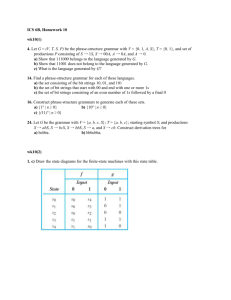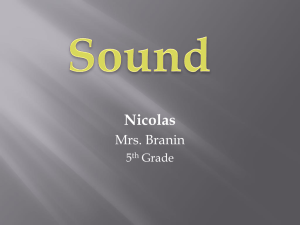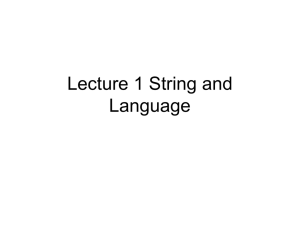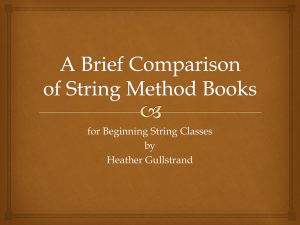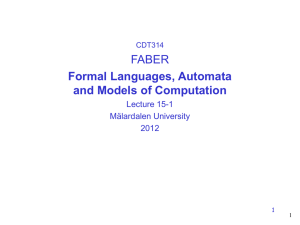PPT - The Stanford University InfoLab
advertisement
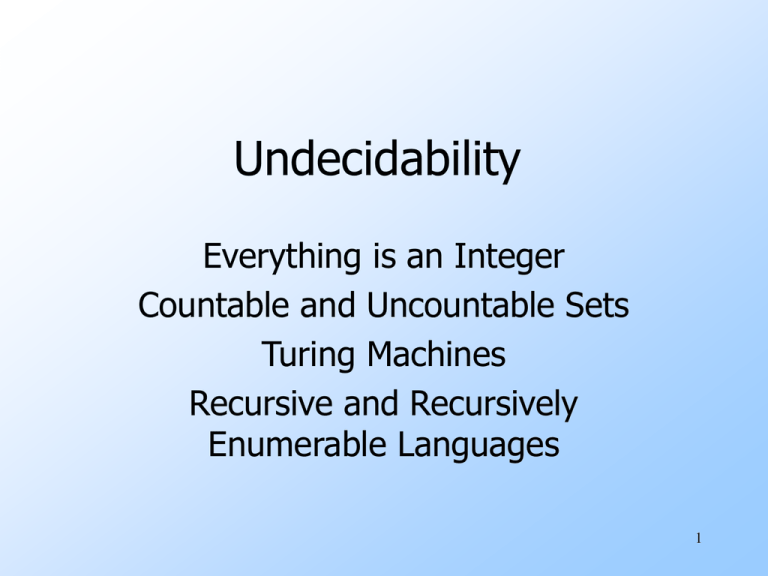
Undecidability
Everything is an Integer
Countable and Uncountable Sets
Turing Machines
Recursive and Recursively
Enumerable Languages
1
Integers, Strings, and Other Things
Data types have become very
important as a programming tool.
But at another level, there is only one
type, which you may think of as
integers or strings.
Key point: Strings that are programs
are just another way to think about the
same one data type.
2
Example: Text
Strings of ASCII or Unicode characters
can be thought of as binary strings,
with 8 or 16 bits/character.
Binary strings can be thought of as
integers.
It makes sense to talk about “the i-th
string.”
3
Binary Strings to Integers
There’s a small glitch:
If you think simply of binary integers, then
strings like 101, 0101, 00101,… all appear
to be “the fifth string.”
Fix by prepending a “1” to the string
before converting to an integer.
Thus, 101, 0101, and 00101 are the 13th,
21st, and 37th strings, respectively.
4
Example: Images
Represent an image in (say) GIF.
The GIF file is an ASCII string.
Convert string to binary.
Convert binary string to integer.
Now we have a notion of “the i-th
image.”
5
Example: Proofs
A formal proof is a sequence of logical
expressions, each of which follows from
the ones before it.
Encode mathematical expressions of
any kind in Unicode.
Convert expression to a binary string
and then an integer.
6
Proofs – (2)
But a proof is a sequence of
expressions, so we need a way to
separate them.
Also, we need to indicate which
expressions are given.
7
Proofs – (3)
Quick-and-dirty way to introduce new
symbols into binary strings:
1. Given a binary string, precede each bit by 0.
Example: 101 becomes 010001.
2. Use strings of two or more 1’s as the special
symbols.
Example: 111 = “the following expression is
given”; 11 = “end of expression.”
8
Example: Encoding Proofs
1110100011111100000101110101…
A given
expression
follows
An expression
End of
expression
Notice this
1 could not
be part of
the “end”
Expression
End
A given
expression
follows
9
Example: Programs
Programs are just another kind of data.
Represent a program in ASCII.
Convert to a binary string, then to an
integer.
Thus, it makes sense to talk about “the
i-th program.”
Hmm…There aren’t all that many
programs.
10
Finite Sets
Intuitively, a finite set is a set for
which there is a particular integer that
is the count of the number of members.
Example: {a, b, c} is a finite set; its
cardinality is 3.
It is impossible to find a 1-1 mapping
between a finite set and a proper
subset of itself.
11
Infinite Sets
Formally, an infinite set is a set for which
there is a 1-1 correspondence between
itself and a proper subset of itself.
Example: the positive integers {1, 2, 3,…}
is an infinite set.
There is a 1-1 correspondence 1<->2, 2<->4,
3<->6,… between this set and a proper
subset (the set of even integers).
12
Countable Sets
A countable set is a set with a 1-1
correspondence with the positive integers.
Hence, all countable sets are infinite.
Example: All integers.
0<->1; -i <-> 2i; +i <-> 2i+1.
Thus, order is 0, -1, 1, -2, 2, -3, 3,…
Examples: set of binary strings, set of Java
programs.
13
Example: Pairs of Integers
Order the pairs of positive integers first
by sum, then by first component:
[1,1], [2,1], [1,2], [3,1], [2,2], [1,3],
[4,1], [3,2],…, [1,4], [5,1],…
Interesting exercise: figure out the
function f(i,j) such that the pair [i,j]
corresponds to the integer f(i,j) in this
order.
14
Enumerations
An enumeration of a set is a 1-1
correspondence between the set and
the positive integers.
Thus, we have seen enumerations for
strings, programs, proofs, and pairs of
integers.
15
How Many Languages?
Are the languages over {0,1}* countable?
No; here’s a proof.
Suppose we could enumerate all
languages over {0,1}* and talk about “the
i-th language.”
Consider the language L = { w | w is the
i-th binary string and w is not in the i-th
language}.
16
Proof – Continued
Lj
Clearly, L is a language over {0,1}*.
x
Thus, it is the j-th language for some
particular j.
Recall: L = { w | w is the
Let x be the j-th string. i-th binary string and w is
not in the i-th language}.
Is x in L?
If so, x is not in L by definition of L.
j-th
If not, then x is in L by definition of L.
17
Diagonalization Picture
Strings
1
2
Languages 3
4
5
…
1
1
2
0
3
1
4
1
5 …
0 …
1
0
0
1
…
18
Diagonalization Picture
Flip each
diagonal
entry
Strings
1
2
Languages 3
4
5
…
1
0
2
0
3
1
4
1
5 …
0 …
0
Can’t be
a row –
it disagrees
in an entry
of each row.
1
1
0
…
19
Proof – Concluded
We have a contradiction: x is neither in
L nor not in L, so our sole assumption
(that there was an enumeration of the
languages) is wrong.
Comment: This is really bad; there are
more languages than programs.
E.g., there are languages with no
membership algorithm.
20
Hungarian Arguments
We have shown the existence of a
language with no algorithm to test for
membership, but we have no way to
exhibit a particular language with that
property.
A proof by counting the things that fail
and claiming they are fewer than all
things is called a Hungarian argument.
21
Turing-Machine Theory
The purpose of the theory of Turing
machines is to prove that certain
specific languages have no algorithm.
Start with a language about Turing
machines themselves.
Reductions are used to prove more
common questions undecidable.
22
Picture of a Turing Machine
Action: based on
the state and the
tape symbol under
the head: change
state, rewrite the
symbol and move the
head one square.
State
...
A
B
C
A
D
...
Infinite tape with
squares containing
tape symbols chosen
from a finite alphabet
23
Why Turing Machines?
Why not deal with C programs or
something like that?
Answer: You can, but it is easier to prove
things about TM’s, because they are so
simple.
And yet they are as powerful as any
computer.
• More so, in fact, since they have infinite memory.
24
Then Why Not Finite-State
Machines to Model Computers?
In principle, you could, but it is not
instructive.
Programming models don’t build in a
limit on memory.
In practice, you can go to Fry’s and buy
another disk.
But finite automata vital at the chip
level (model-checking).
25
Turing-Machine Formalism
A TM is described by:
1.
2.
3.
4.
A finite set of states (Q, typically).
An input alphabet (Σ, typically).
A tape alphabet (Γ, typically; contains Σ).
A transition function (δ, typically).
5. A start state (q0, in Q, typically).
6. A blank symbol (B, in Γ- Σ, typically).
All tape except for the input is blank initially.
7. A set of final states (F ⊆ Q, typically).
26
Conventions
a, b, … are input symbols.
…, X, Y, Z are tape symbols.
…, w, x, y, z are strings of input
symbols.
, ,… are strings of tape symbols.
27
The Transition Function
Takes two arguments:
1. A state, in Q.
2. A tape symbol in Γ.
δ(q, Z) is either undefined or a triple of
the form (p, Y, D).
p is a state.
Y is the new tape symbol.
D is a direction, L or R.
28
Actions of the PDA
If δ(q, Z) = (p, Y, D) then, in state q,
scanning Z under its tape head, the
TM:
1. Changes the state to p.
2. Replaces Z by Y on the tape.
3. Moves the head one square in direction D.
D = L: move left; D = R; move right.
29
Example: Turing Machine
This TM scans its input right, looking
for a 1.
If it finds one, it changes it to a 0, goes
to final state f, and halts.
If it reaches a blank, it changes it to a
1 and moves left.
30
Example: Turing Machine – (2)
States = {q (start), f (final)}.
Input symbols = {0, 1}.
Tape symbols = {0, 1, B}.
δ(q, 0) = (q, 0, R).
δ(q, 1) = (f, 0, R).
δ(q, B) = (q, 1, L).
31
Simulation of TM
δ(q, 0) = (q, 0, R)
δ(q, 1) = (f, 0, R)
δ(q, B) = (q, 1, L)
q
... B B 0 0 B B ...
32
Simulation of TM
δ(q, 0) = (q, 0, R)
δ(q, 1) = (f, 0, R)
δ(q, B) = (q, 1, L)
q
... B B 0 0 B B ...
33
Simulation of TM
δ(q, 0) = (q, 0, R)
δ(q, 1) = (f, 0, R)
δ(q, B) = (q, 1, L)
q
... B B 0 0 B B ...
34
Simulation of TM
δ(q, 0) = (q, 0, R)
δ(q, 1) = (f, 0, R)
δ(q, B) = (q, 1, L)
q
... B B 0 0 1 B ...
35
Simulation of TM
δ(q, 0) = (q, 0, R)
δ(q, 1) = (f, 0, R)
δ(q, B) = (q, 1, L)
q
... B B 0 0 1 B ...
36
Simulation of TM
δ(q, 0) = (q, 0, R)
δ(q, 1) = (f, 0, R)
δ(q, B) = (q, 1, L)
f
... B B 0 0 0 B ...
No move is possible.
The TM halts and
accepts.
37
Instantaneous Descriptions of
a Turing Machine
Initially, a TM has a tape consisting of a
string of input symbols surrounded by
an infinity of blanks in both directions.
The TM is in the start state, and the
head is at the leftmost input symbol.
38
TM ID’s – (2)
An ID is a string q, where is the
tape between the leftmost and
rightmost nonblanks (inclusive).
The state q is immediately to the left of
the tape symbol scanned.
If q is at the right end, it is scanning B.
If q is scanning a B at the left end, then
consecutive B’s at and to the right of q are
part of .
39
TM ID’s – (3)
As for PDA’s we may use symbols ⊦ and
⊦* to represent “becomes in one move”
and “becomes in zero or more moves,”
respectively, on ID’s.
Example: The moves of the previous TM
are q00⊦0q0⊦00q⊦0q01⊦00q1⊦000f
40
Formal Definition of Moves
1. If δ(q, Z) = (p, Y, R), then
qZ⊦Yp
If Z is the blank B, then also q⊦Yp
2. If δ(q, Z) = (p, Y, L), then
For any X, XqZ⊦pXY
In addition, qZ⊦pBY
41
Languages of a TM
A TM defines a language by final state,
as usual.
L(M) = {w | q0w⊦*I, where I is an ID
with a final state}.
Or, a TM can accept a language by
halting.
H(M) = {w | q0w⊦*I, and there is no
move possible from ID I}.
42
Equivalence of Accepting and
Halting
1. If L = L(M), then there is a TM M’
such that L = H(M’).
2. If L = H(M), then there is a TM M”
such that L = L(M”).
43
Proof of 1: Acceptance ->
Halting
Modify M to become M’ as follows:
1. For each accepting state of M, remove any
moves, so M’ halts in that state.
2. Avoid having M’ accidentally halt.
Introduce a new state s, which runs to the right
forever; that is δ(s, X) = (s, X, R) for all symbols X.
If q is not accepting, and δ(q, X) is undefined, let
δ(q, X) = (s, X, R).
44
Proof of 2: Halting ->
Acceptance
Modify M to become M” as follows:
1. Introduce a new state f, the only
accepting state of M”.
2. f has no moves.
3. If δ(q, X) is undefined for any state q and
symbol X, define it by δ(q, X) = (f, X, R).
45
Recursively Enumerable
Languages
We now see that the classes of
languages defined by TM’s using final
state and halting are the same.
This class of languages is called the
recursively enumerable languages.
Why? The term actually predates the
Turing machine and refers to another
notion of computation of functions.
46
Recursive Languages
An algorithm is a TM that is
guaranteed to halt whether or not it
accepts.
If L = L(M) for some TM M that is an
algorithm, we say L is a recursive
language.
Why? Again, don’t ask; it is a term with a
history.
47
Example: Recursive
Languages
Every CFL is a recursive language.
Use the CYK algorithm.
Every regular language is a CFL (think
of its DFA as a PDA that ignores its
stack); therefore every regular
language is recursive.
Almost anything you can think of is
recursive.
48
